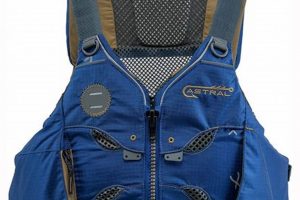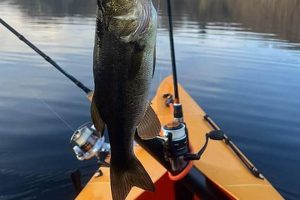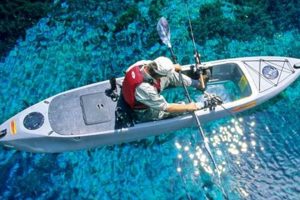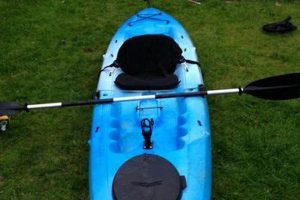A device secures fishing rods to kayaks, typically consisting of a clamp for attachment and a cradle or grip to hold the rod. These devices come in various designs, materials, and mounting options, accommodating different rod types and kayak setups. For instance, some feature adjustable angles and rotations, while others offer quick-release mechanisms for easy access.
Secure rod storage and hands-free operation are vital for kayak anglers. These devices prevent rod loss or damage during navigation, paddling, and landing fish. They also free up the angler’s hands for other tasks like paddling, baiting hooks, or handling fish. This equipment has evolved alongside the growing popularity of kayak fishing, improving from basic DIY solutions to sophisticated, purpose-built designs enhancing the angling experience.
This article will delve into various aspects of selecting, installing, and using these essential tools for kayak fishing, covering topics such as different types, materials, mounting locations, and compatibility with various kayak and rod types.
Tips for Choosing and Using Rod Holders
Proper selection and utilization of these devices are crucial for a successful and enjoyable kayak fishing experience. The following tips offer guidance for maximizing their benefits.
Tip 1: Consider Kayak Compatibility: Ensure the chosen device is compatible with the kayak’s material and mounting points. Track-mounted systems offer flexibility, while clamp-on models require suitable gunwales or rails. Inflatable kayaks may have specific attachment points or require specialized holders.
Tip 2: Evaluate Rod and Reel Types: Match the holder to the intended rod and reel combination. Spinning, baitcasting, and fly fishing rods often require different holder designs. Consider the rod’s length and weight capacity as well.
Tip 3: Prioritize Adjustability and Security: Opt for models offering adjustable angles and rotation to accommodate different fishing techniques and target species. Secure locking mechanisms prevent accidental rod dislodgement during challenging conditions.
Tip 4: Choose Durable and Corrosion-Resistant Materials: Marine-grade materials, such as stainless steel or anodized aluminum, withstand harsh saltwater environments and provide long-lasting performance. Avoid plastic components prone to breakage or UV degradation.
Tip 5: Position Holders Strategically: Placement impacts accessibility and minimizes interference with paddling and other activities. Consider mounting locations that allow for easy reach and retrieval without compromising stability.
Tip 6: Regularly Inspect and Maintain Holders: Periodically check for loose screws, worn parts, or signs of corrosion. Tighten or replace components as needed to maintain optimal performance and prevent equipment failure.
Tip 7: Practice Safe Handling: Exercise caution when handling rods in and around the holders, especially during navigation or when encountering rough water. Secure rods properly to prevent entanglement or injury.
By adhering to these guidelines, anglers can enhance their kayak fishing experience with secure, efficient, and convenient rod management, improving their overall success and enjoyment on the water.
This information serves as a comprehensive guide to selecting and utilizing essential equipment for kayak angling. The concluding section will reiterate key takeaways and offer additional resources.
1. Secure Mounting
Secure mounting forms the foundation of effective kayak fishing rod holder clamp utility. A stable and reliable connection between the clamp and the kayak ensures consistent performance and prevents equipment loss or damage. Understanding the elements contributing to secure mounting is critical for anglers.
- Clamp Mechanisms:
Various clamp designs exist, each offering different levels of security and adaptability. Common mechanisms include lever-activated clamps, screw-down clamps, and track-mounted systems. Lever clamps provide quick attachment and detachment, while screw-down clamps offer greater holding power. Track systems allow for flexible positioning along the kayak’s tracks. Selecting the appropriate clamp mechanism depends on the kayak’s structure and the angler’s preferences.
- Mounting Surface Compatibility:
The clamp’s compatibility with the kayak’s mounting surface is crucial. Clamp jaws must securely grip the kayak’s gunwales, rails, or other designated mounting points. Incompatibility can lead to slippage or instability, jeopardizing rod security. Anglers should verify clamp specifications and compatibility before installation.
- Material and Construction:
Durable, corrosion-resistant materials are essential for long-lasting secure mounting. High-quality clamps typically employ marine-grade stainless steel, anodized aluminum, or reinforced polymers. Robust construction ensures the clamp withstands the stresses of fishing and the harsh marine environment.
- Proper Installation Techniques:
Correct installation is paramount for secure mounting. Following manufacturer instructions and utilizing appropriate tools ensures optimal clamp performance. Over-tightening can damage the kayak or the clamp, while under-tightening can lead to instability. Careful attention to installation details maximizes clamp security and longevity.
These facets of secure mounting collectively contribute to the overall effectiveness and reliability of a kayak fishing rod holder clamp. A secure mount safeguards valuable equipment, enhances angler efficiency, and contributes to a safer and more enjoyable fishing experience. By understanding these principles, anglers can make informed decisions regarding clamp selection and installation, maximizing their on-the-water success.
2. Material Durability
Material durability is paramount for kayak fishing rod holder clamps due to the demanding marine environment. Exposure to saltwater, UV radiation, and physical stresses necessitates robust construction to ensure longevity and reliable performance. Choosing appropriate materials directly impacts the clamp’s resistance to corrosion, wear, and impact damage, safeguarding both the fishing rod and the kayak itself.
- Corrosion Resistance:
Saltwater environments accelerate corrosion, compromising structural integrity and leading to equipment failure. Materials like marine-grade stainless steel and anodized aluminum exhibit high corrosion resistance, ensuring long-term functionality. For instance, 316 stainless steel, commonly used in marine applications, forms a passive chromium oxide layer, protecting the underlying metal from corrosive attack. Conversely, lower-grade stainless steel or non-coated metals are susceptible to rust and degradation, reducing clamp lifespan.
- UV Resistance:
Prolonged exposure to sunlight degrades certain materials, causing them to become brittle and prone to cracking. UV-resistant polymers and coatings protect against sun damage, maintaining material strength and flexibility. High-quality rod holder clamps often incorporate UV stabilizers into plastic components, extending their service life. Conversely, non-UV stabilized plastics become weakened and discolored over time, compromising their structural integrity.
- Impact Resistance:
Accidental impacts, rough handling, and the jostling inherent in kayak fishing can subject rod holder clamps to significant forces. Impact-resistant materials, such as reinforced polymers or high-strength alloys, minimize the risk of breakage or deformation. Nylon and fiberglass-reinforced plastics offer good impact resistance while remaining lightweight. Conversely, brittle materials like some lower-grade plastics may crack or shatter upon impact, rendering the clamp unusable.
- Wear Resistance:
Repeated insertion and removal of fishing rods, combined with exposure to abrasive elements like sand and grit, can cause wear and tear on the clamp’s contact surfaces. Hardened materials and specialized coatings enhance wear resistance, preserving the clamp’s functionality over time. For instance, hard-coat anodizing increases aluminum’s surface hardness and abrasion resistance. Conversely, softer materials are more susceptible to scratches and wear, potentially affecting rod security and clamp performance.
Careful consideration of these material properties ensures the selection of a durable and reliable kayak fishing rod holder clamp. Investing in high-quality, corrosion-resistant, UV-resistant, impact-resistant, and wear-resistant materials ensures long-term performance, safeguards valuable fishing equipment, and contributes to a safer and more enjoyable fishing experience. Neglecting material durability can lead to premature failure, equipment loss, and potentially compromised safety.
3. Adjustability
Adjustability in kayak fishing rod holder clamps is crucial for optimizing fishing techniques and adapting to diverse water conditions. A flexible system allows anglers to position rods strategically, enhancing lure presentation, hook sets, and overall fishing effectiveness. Without adjustability, anglers are limited in their ability to respond to changing circumstances, potentially hindering their success and enjoyment on the water.
- Angle Adjustment:
The ability to adjust the rod’s angle relative to the waterline is critical for various fishing techniques. For example, trolling often requires a shallow angle, while vertical jigging necessitates a steeper angle. Adjustable clamps allow anglers to fine-tune rod positioning, maximizing lure action and sensitivity. Fixed-angle holders limit versatility and may be unsuitable for certain fishing styles.
- Rotation Adjustment:
Rotational adjustability allows anglers to change the rod’s orientation relative to the kayak. This feature is essential for techniques like trolling or drifting, where maintaining a specific rod angle relative to the current or boat direction is crucial. Rotational control prevents line twisting and ensures optimal lure presentation. Limited rotation can hinder maneuverability and decrease fishing effectiveness.
- Height Adjustment:
Adjusting the rod’s height above the waterline can be beneficial for certain techniques or when navigating varying water depths. Higher rod positions can prevent snags in shallow water, while lower positions may be preferred for deep-water fishing. Adjustable height also accommodates different rod lengths and angler preferences. Fixed-height holders restrict adaptability and may compromise fishing efficiency in certain situations.
- Horizontal Adjustment:
Horizontal adjustment, often facilitated by track systems, allows anglers to shift the rod’s position along the kayak’s length. This feature is beneficial for managing multiple rods, accommodating different fishing styles, and optimizing weight distribution within the kayak. Fixed-position holders lack this versatility, potentially hindering rod management and kayak stability.
These aspects of adjustability collectively contribute to a more versatile and effective kayak fishing experience. An adjustable rod holder clamp empowers anglers to adapt to changing conditions, optimize their techniques, and maximize their chances of success. The ability to fine-tune rod position enhances lure presentation, improves hook sets, and allows for greater control over the fishing process. Investing in an adjustable system significantly enhances the overall kayak fishing experience.
4. Compatibility
Compatibility between kayak fishing rod holder clamps and various kayak and rod types is paramount for achieving a secure, functional, and efficient fishing setup. A mismatch can lead to instability, equipment damage, and a compromised fishing experience. Ensuring proper compatibility requires careful consideration of several key factors.
- Kayak Mounting Systems:
Kayaks feature diverse mounting systems, including tracks, rails, gunwales, and specialized inserts. Rod holder clamps must be designed to securely attach to the specific mounting system of the intended kayak. For example, track-mounted clamps utilize sliding mechanisms to attach to kayak tracks, while rail mounts clamp onto raised rails. Using an incompatible clamp can result in an insecure fit, potentially leading to clamp slippage or damage to the kayak.
- Rod and Reel Types:
Different fishing rod and reel types have varying dimensions, weights, and handle configurations. Rod holder clamps must accommodate the specific rod and reel being used. For instance, spinning rods require holders that can accommodate the reel’s foot and prevent rotation, while baitcasting reels require holders that offer secure grip and clearance for the reel’s larger profile. Using an inappropriate holder can result in an unstable rod position or damage to the reel.
- Clamp Material and Kayak Material:
The materials used in both the clamp and the kayak’s mounting surface influence compatibility. Certain clamp materials may react with specific kayak materials, potentially leading to corrosion or degradation. For example, aluminum clamps in direct contact with carbon fiber kayaks can create galvanic corrosion. Using compatible materials ensures long-term integrity and prevents damage to both the clamp and the kayak.
- Size and Weight Capacity:
Rod holder clamps have specific size and weight limitations. Exceeding these limits can compromise clamp stability and potentially lead to equipment failure. Matching the clamp’s capacity to the size and weight of the intended rod and reel is crucial. Using an undersized clamp can result in an insecure hold, increasing the risk of rod loss or damage.
Proper compatibility between the kayak fishing rod holder clamp, the kayak, and the fishing rod ensures a secure, stable, and functional fishing platform. Careful consideration of mounting systems, rod types, materials, and weight capacities allows anglers to select the appropriate clamp, maximizing efficiency and enhancing the overall fishing experience. Ignoring compatibility issues can lead to equipment damage, instability, and a compromised fishing trip.
5. Ease of Use
Ease of use is a critical factor influencing the overall effectiveness and enjoyment of kayak fishing. A rod holder clamp that is cumbersome or difficult to operate can detract from the fishing experience, reducing efficiency and potentially compromising safety. Streamlined operation, intuitive design, and readily accessible features enhance angler focus and contribute to a more productive and enjoyable outing.
- Single-Handed Operation:
The ability to secure or release a fishing rod with one hand is essential in kayak fishing. Often, the other hand is needed for paddling, maintaining balance, or handling other equipment. A rod holder clamp featuring a quick-release mechanism, such as a lever or trigger, allows for swift and efficient rod management without compromising stability or requiring awkward maneuvers. Conversely, clamps requiring two hands for operation can be cumbersome and potentially unsafe in dynamic kayaking environments.
- Intuitive Design:
A well-designed rod holder clamp should be intuitive to operate, even in challenging conditions or low-light situations. Clear markings, ergonomic shapes, and readily identifiable components minimize fumbling and reduce the cognitive load on the angler. Intuitive design allows for quick and seamless rod access and storage, enhancing fishing efficiency and minimizing distractions. Conversely, complex or poorly designed clamps can lead to frustration and wasted time, detracting from the fishing experience.
- Secure Locking Mechanisms:
Reliable locking mechanisms are crucial for preventing accidental rod dislodgement during paddling, maneuvering, or encountering rough water. A secure lock provides peace of mind, allowing anglers to focus on fishing without constantly worrying about losing valuable equipment. Robust locking mechanisms, such as positive locking levers or secure cam systems, ensure that rods remain firmly in place even under stress. Conversely, weak or unreliable locks can lead to rod loss, potentially jeopardizing safety and incurring unnecessary expense.
- Smooth Rod Insertion and Removal:
Friction-free rod insertion and removal are essential for quick transitions between fishing and paddling or other activities. Rod holders with smooth, contoured cradles or grips minimize resistance, allowing for effortless rod placement and retrieval. This streamlined operation enhances efficiency and prevents unnecessary delays or frustration. Conversely, holders with rough surfaces or tight tolerances can create friction, making it difficult to quickly secure or release a rod.
These facets of ease of use contribute significantly to the overall effectiveness and enjoyment of kayak fishing. A user-friendly rod holder clamp allows anglers to focus on the task at hand, maximizing their time on the water and enhancing their chances of success. Investing in a well-designed, easy-to-use system improves fishing efficiency, reduces frustration, and contributes to a safer and more rewarding kayak fishing experience.
Frequently Asked Questions
This section addresses common inquiries regarding kayak fishing rod holder clamps, providing concise and informative responses to facilitate informed decision-making and optimal utilization.
Question 1: What materials are best suited for saltwater environments?
Marine-grade stainless steel (e.g., 316 stainless steel) and anodized aluminum offer excellent corrosion resistance in saltwater. While some high-quality polymers can be suitable, metal components generally provide greater longevity and durability.
Question 2: How many rod holders are recommended for a kayak?
The optimal number depends on individual fishing style and kayak capacity. Two holders are often sufficient for most anglers, allowing for one rod in use and one stored. Some anglers may prefer more holders for diverse techniques or carrying multiple setups.
Question 3: Can these devices be used with any type of kayak?
Compatibility varies depending on the kayak’s construction and mounting points. Check manufacturer specifications for compatibility with specific kayak models, particularly inflatable or specialized kayaks.
Question 4: How does one choose the correct clamp size?
Clamp size must correspond to the diameter of the kayak’s rails, gunwales, or other intended mounting points. Measure the mounting surface carefully before selecting a clamp to ensure a secure and stable fit.
Question 5: What maintenance is required for these devices?
Regularly rinse with freshwater after each use, especially in saltwater. Inspect for loose screws, corrosion, or wear, and tighten or replace components as needed. Periodic lubrication of moving parts can enhance functionality and longevity.
Question 6: Are these devices difficult to install?
Installation typically involves attaching the clamp to the kayak using screws or other provided hardware. Most manufacturers provide detailed instructions. Basic hand tools are usually sufficient for installation.
Careful consideration of these frequently asked questions assists in selecting, installing, and maintaining appropriate equipment. Choosing the right equipment contributes significantly to a successful and enjoyable kayak fishing experience.
This concludes the FAQ section. The following section provides a summary of key takeaways and additional resources for further exploration.
Conclusion
Kayak fishing rod holder clamps are essential equipment for anglers seeking efficient rod management and enhanced fishing experiences. Material durability, secure mounting, adjustability, compatibility, and ease of use are critical factors influencing selection and utilization. Corrosion-resistant materials like marine-grade stainless steel ensure longevity in harsh marine environments. Secure mounting mechanisms, compatible with various kayak types, prevent equipment loss or damage. Adjustability allows for customized rod positioning, optimizing various fishing techniques. Compatibility with different rod and reel types ensures a secure and stable hold. Ease of use, facilitated by features like single-handed operation and intuitive design, enhances angler efficiency and enjoyment. Careful consideration of these factors contributes significantly to a safe, productive, and fulfilling kayak fishing experience.
Effective rod management is paramount for successful kayak angling. Strategic equipment choices empower anglers to navigate diverse water conditions, employ various fishing techniques, and maximize their chances of success. Investing in high-quality, well-designed kayak fishing rod holder clamps represents an investment in enhanced fishing experiences and contributes to the overall enjoyment and success on the water.






